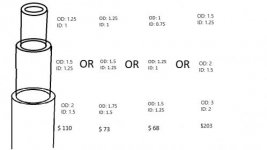HetNeedsHelp
Plastic
- Joined
- Jul 29, 2020
Hello, I have very little experience in machining, mostly aluminum and wood.
My team is making a ground mount for an antenna on a tall building for which we are using fiberglass tubes. We want to make a telescopic mount using 3 similarly sized fiberglass tubes (1.5in OD, .25in thick).
So my question is;
1) what is the best way to turn a fiberglass tube on a lathe to shave off some mm in thickness?
2) we also need to drill some holes into the tube, any tips?
I have 0 experience with fiberglass machining as I said, so any tips are appreciated.
Thank you.
My team is making a ground mount for an antenna on a tall building for which we are using fiberglass tubes. We want to make a telescopic mount using 3 similarly sized fiberglass tubes (1.5in OD, .25in thick).
So my question is;
1) what is the best way to turn a fiberglass tube on a lathe to shave off some mm in thickness?
2) we also need to drill some holes into the tube, any tips?
I have 0 experience with fiberglass machining as I said, so any tips are appreciated.
Thank you.




